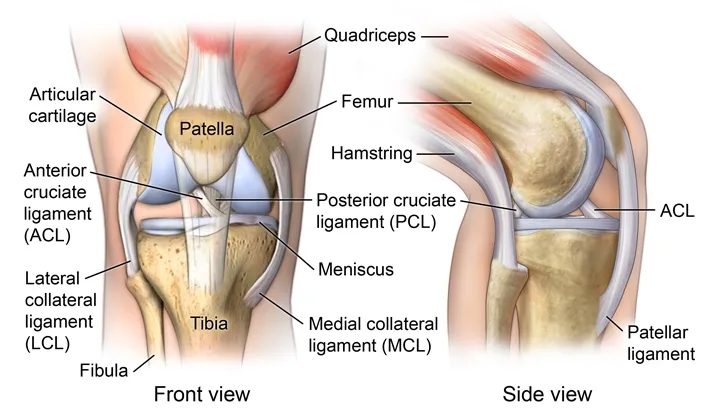The Knee Injury and How to Overcome

Tiger Woods! A professional golfer certified by Forbes as a self-made billionaire, he is the second active athlete to reach the epitome of riches, following LeBron James.
But did you know that success comes with hard work, and... sacrifices?
Behind his prosperity, Woods has suffered a lot of injuries. One of his earliest was a knee injury in 2002 when he had surgery to remove fluid from the anterior cruciate ligament (ACL) of his left knee.
In April 2008, he had arthroscopic surgery to repair cartilage damage to the same knee. Following this, he suffered a stress fracture of his left tibia, which led to reconstructive surgery on his ACL in June of that year.
Then, in 2011, Woods shared with reporters, "The knee acted up and then the Achilles' followed after that." At the time, he had sustained a sprain to the middle cruciate ligament (MCL) of his left knee and a strain on his left Achilles tendon.
From this, we learn that an injury can persist and re-emerge over time, despite undergoing therapy. On the flip side, investing in proper treatment can prevent future injuries.
According to the British Journal of Sports Medicine, knee injuries comprise 41% of sports injuries. However, even for not-athletes, knee pain is the second most commonly reported area of pain in the body, after back pain.
It can lead to a loss of productivity, disability, and even complaints of pocket-related reasons caused by therapies and medical equipment for the sake of easing the pain—a.k.a. It's expensive!
Knee pain can be caused by injuries, mechanical issues, and various types of arthritis that affect both old and young adults. Other contributing factors include obesity, a sedentary lifestyle, and even trauma caused by repetitive movements.
Types of knee pain

The knee consists of four main structures: the bones, cartilage (including articular and meniscus), ligaments (collateral and cruciate), and tendons. When something goes wrong, injuries may affect one or more of these structures, leading to various types of knee pain, including
1. Sprain and strain
A strain happens when a muscle or tendon (fibrous cords that connect muscles to bones) is torn or stretched. It happens when the ligaments (flexible fibrous tissue that connects two bones and provides stability to joints) in the knee joint are stretched or torn, usually caused by overuse, trauma, or repetitive injuries.
2. Tears of the soft tissues (ligaments, meniscus, etc.)
- Anterior Cruciate ligament (ACL) injuries
This injury often happens in people who participate in pivoting sports or sports that cause rapid directional change or incorrect landings from jumps, such as soccer, football, and basketball.
- Posterior Cruciate Ligament (PCL) injuries
PCL injuries typically result from a strong force (trauma) to the knee in a bent position, such as during a car accident, falling hard on a bent knee, or landing awkwardly after a jump.
- Collateral Ligament injuries
These injuries happen when a force pushes the knee sideways. Pain on the inside of the knee indicates a Medial Collateral Ligament (MCL) injury, caused by inward force. Pain on the outside indicates a Lateral Collateral Ligament (LCL) injury, caused by an outward force.
- Meniscal tear
Meniscal tears are common in sports and can occur during twisting, cutting, pivoting, and tackling. They also result from arthritis or the natural aging process.
- Tendon tear
Tendons connect muscles and joints. Tendon tears can happen suddenly if a tendon is strained or due to trauma. Long-term inflammation, such as tendonitis, can also lead to tears. Patellar and/or quadriceps tendon tears may occur near the knee cap.
3. Fracture
Broken bone near the knee commonly happens on the patella. The Femur and tibia, which meet the knees, can also fracture when intense trauma or collision occurs, most often in a vehicle accident.
4. Dislocation
A dislocation happens when the knee is either completely or partially out of place. In normal conditions, this results from trauma such as falls, collisions, vehicle accidents, or sports-related injuries. For individuals with abnormal knee anatomy, the risk of dislocation is higher.
5. Others
Knee pain may also result from aging conditions such as arthritis (osteoarthritis, rheumatoid arthritis), tendonitis, bursitis, and old injuries. It may also be caused by being overweight, known as weight-bearing pain. In rare cases, infections may also occur.
What to look out for?
- Pain
- Swelling and stiffness.
- Redness and heat to the touch.
- Weakness or instability or immobilization of the knee/limping
- Hearing a popping or crouching (crepitus) noise and feel.
- Inability to straighten the knee.
What do you do when the injury happens?

A doctor will first need to diagnose the injury based on your medical history, physical examination, and advanced knee tests such as X-ray, MRI, CT scan, Arthroscopy, and other bone scans to determine whether surgery is necessary.
If surgery is not required, remember the RICE method for a speedy recovery.
R: Rest. Avoid putting weight on the injured knee. Pain is the body's signal to rest, so please don't try the "no pain, no gain" philosophy, as this can intensify the injury.
I: Ice. use cold packs for 20 minutes at a time, several times a day. Do not apply ice directly to the skin, instead, use an ice pack. Ice treatment is recommended for 2-3 days during the acute inflammation phase.
C: Compression. Lightly wrap the injured area in a soft or elastic medical bandage to prevent swelling. The wrap should be snug but not too tight for it will restrict blood flow. Be sure to check for any cold, tingling, or numb sensation, as these are signs the bandage may be too tight and needs to be loosened.
E: Elevation. To reduce swelling, elevate the injured knee above the level of the heart while resting. This can help reduce pain, throbbing, and swelling.
How to prevent injury

1. Maintain a healthy weight
Regulating your weight, or losing excess weight, plays a crucial role in reducing knee damage.
2. Avoid heavy-impact exercises
If you can’t avoid them, be sure to stretch before and after exercising. Warming up and cooling down are essential to prevent injury.
3. Keep your knees moving
Avoid staying stationary for a long period. Exercise helps keep the knee flexible, but avoid overworking them with activities like lifting very heavy objects or going up and down stairs, which put extra strain on the knees. Find balance and listen to your body when it signals pain.
4. Wear proper footwear
The right shoes can help reduce the risk of knee injuries.
5. Eat the right food
According to WHO, a healthy diet per energy intake for adults includes 400 g of fruits and vegetables daily, less than 30% fat, less than 10% sugar, less than 5g salt per day, and 40-70% of carbohydrates. If it feels complicated to count the precise amount, there are plenty of nutritious calculators available online to help.
Foods for healthy joints: seed and nuts, cold-water fish, fruits (blueberries, pineapples, tomatoes), olive oils, and whole grains.
Foods to avoid: processed foods, fried foods, oils high in omega-6 fatty acids or saturated fats, sugar, and refined carbohydrates.
If you experience knee pain, don't panic. Visit GWS Medika Clinic, a health clinic, for a diagnosis and treatment.
Leaving you with one interesting fact: a study involving 2,607 people (average age of 64, 44% are men) without arthritis found that "overall, rates of knee osteoarthritis and pain were 20% lower among those who did strength training versus those who never tried it", according to a study published online October 23rd, 2023, by Arthritis & Rheumatology.
So resistance training might be a great future health investment, don’t you think?



